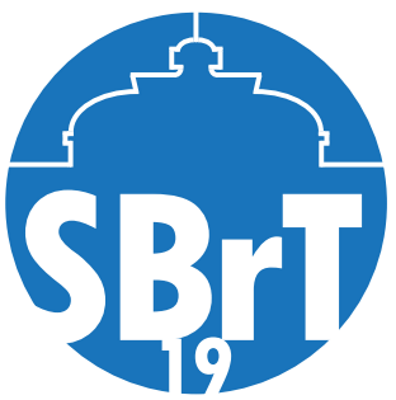
XXXVII Simpósio Brasileiro de Telecomunicações e Processamento de Sinais
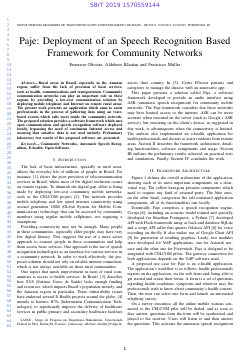
Paje: Deployment of an Speech Recognition Based Framework for Community Networks
Emerson Oliveira, Aldebaro Klautau, Francisco C. B. F. Müller
DOI: 10.14209/sbrt.2019.1570559144
Keywords:
Abstract
Rural areas in Brazil, especially in the Amazon region, suffers from the lack of provision of basic services, such as health, communications and transportation. Community communication networks can play an important role on these regions by providing a low-cost communication solution by deploying mobile telephony and Internet on remote rural areas. The present work presents an application which aims to assist professionals in the process of gathering data using an voice-based system which calls users inside the community network. The proposed solution provides an software framework which uses open communication and speech recognition software deployed locally, bypassing the need of continuous Internet access and assuring that sensitive data is not used unfairly. Preliminary laboratory test results of the proposed software are presented.Download
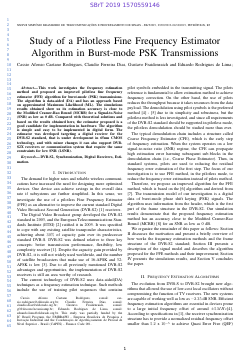
Study of a Pilotless Fine Frequency Estimator Algorithm in Burst-mode PSK Transmissions
Cassio C Rodrigues, Claudio Dias, Gustavo Fraidenraich, Eduardo de Lima
DOI: 10.14209/sbrt.2019.1570559146
Keywords:
Abstract
This work investigated the frequency estimation method and proposed an improved pilotless fine frequency estimator (FFE) algorithm for burst-mode (PSK) transmissions. The algorithm is data-aided (DA) and has an approach based on approximated Maximum Likelihood (ML). The simulations results obtained show us its estimation accuracy is close to the Modified Cramer-Rao Bound (MCRB) for a Signal-to-Noise (SNR) as low as 0 dB. Compared with theoretical solutions and based on the results obtained here, the estimator proposed is the best candidate for implementation in hardware. The algorithm is simple and easy to be implemented in digital form. The estimator was developed targeting a digital receiver for the DVB-S2 standard, that is under development in 65nm CMOS technology, and with minor changes it can also support DVBS2X receivers or communication system that requires the same constraints for low SNR (LSNR).Download
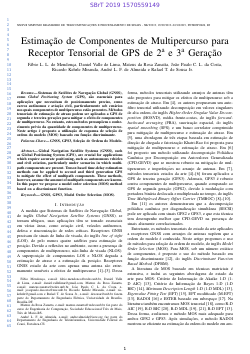
Estimação de Componentes de Multipercurso para Receptor Tensorial de GPS de 2a e 3a Geração
Fábio Lúcio Lopes de Mendonça, Daniel Valle de Lima, Mateus R Zanatta, Joao Paulo Carvalho Lustosa da Costa, Ricardo Kehrle Miranda, André de Almeida, Rafael Timoteo de Sousa Junior
DOI: 10.14209/sbrt.2019.1570559149
Keywords:
Abstract
Sistemas de positionamento global (GNSS), como \textit{Global Positioning System} (GPS), são essenciais para aplicações que necessitam posionamento acurado, como carros autônomos e aviação civil, particularmente sob cenários nos quais componentes de multipercurso estão presentes. Métodos tensoriais de estimação de atraso podem ser aplicados a GPS de segunda e terceira geração para mitigar o efeito de componentes de multipercurso. No entanto, estes métodos pressupõem o conhecimento prévio da quantidade de componentes de multipercurso. Neste artigo é proposto um esquema de seleção de ordem do modelo (MOS) baseado em função discriminante aplicável também em cenários em que há ruído colorido.Download

Uso de Rede de Telefonia Celular Comunitária para Inclusão Social e Digital na Amazônia
Lauro Castro, Giovanni Leão, Emerson Oliveira, Francisco C. B. F. Müller, Aldebaro Klautau, Marcus Dias
DOI: 10.14209/sbrt.2019.1570559156
Keywords:
Abstract
Community networks deployment is one of several worldwide efforts to reduce the digital divide. Most of these networks rely entirely on IEEE 802.11 (WiFi). In this work, the authors describe the application of an international cellular telephone network (2G-GSM) operating on licensed spectrum and capable of using regular cellphones to provide social and digital inclusion in a community in the Amazon forest. The contribution a functional network, based on open source technologies, which is used to foster research on the impact on the community.Download

Modelo de Otimização para Engenharia de Tráfego Usando Roteamento por Segmentos
Antonio Jose Silverio, Miguel Elias Mitre Campista, Rodrigo S. Couto, Luis Henrique M. K. Costa
DOI: 10.14209/sbrt.2019.1570559158
Keywords:
Abstract
Neste artigo formula-se um problema de otimização combinatória biobjetivo em duas etapas,aplicável a redes de roteadores de núcleo de operadoras de telecomunicações, considerando uma rede de backbone com roteamento por segmentos e engenharia de tráfego. O modelo tem a finalidade de distribuir os fluxos considerando condições de gargalos de capacidade e métricas de rede estabelecidas pela operadora da rede. Resultados baseados em exemplos reais são apresentados, demonstrando-se os benefícios do modelo em relação ao estado da arte das propostas de modelagem de roteamento por segmentos, como o tratamento de múltiplos objetivos de rede minimizando a quantidade de segmentos.Download

Data Validation Scheme Using Meaningless Reversible Degradation and NFC
Kevin S. Araujo, Max E. Vizcarra Melgar
DOI: 10.14209/sbrt.2019.1570559159
Keywords:
Abstract
This paper presents a novel data validation system using meaningless reversible degradation and the Near-Field Communication (NFC) protocol. The NFC protocol is widely used as data exchange channel due to its technical properties, such as data transfer rate and transmission reliability. The proposed scheme exploits reversible degradation properties, using the systematic Berlekamp Reed-Solomon error correction algorithm and the NFC on three error correction levels: Low (5%), Medium (15%), and High (25%). This new mechanism allows encoding data on a meaningless file, which can be posteriorly retrieved using an authorized NFC card. Thus, to retrieve and validate the file, the part that receives the corrupted file, and the authorizing part, must be physically near to allow decoding the file. Once the authorizing part removes the NFC card, the decoded file becomes meaningless again and is closed.Download
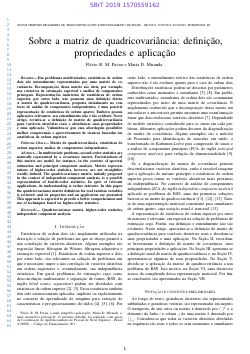
Sobre a matriz de quadricovariância: definição, propriedades e aplicação
Flávio R. M. Pavan, Maria D. Miranda
DOI: 10.14209/sbrt.2019.1570559162
Keywords:
Abstract
Em problemas multivariados, estatísticas de ordem dois são naturalmente representadas por uma matriz de covariância. Decomposições dessa matriz são úteis, por exemplo, nos contextos de estimação espectral e análise de componentes principais. Representações matriciais de estatísticas de ordem superior, por outro lado, não possuem uma definição direta. A matriz de quadricovariância, proposta inicialmente no contexto de análise de componentes independentes, é uma possível representação de estatísticas de ordem quatro. Embora possua aplicações relevantes, seu entendimento não é tão evidente. Neste artigo, revisita-se a definição de matriz de quadricovariância para variáveis aleatórias reais e abordam-se suas propriedades e uma aplicação. Vislumbra-se que essa abordagem possibilite melhor compreensão e aproveitamento de técnicas baseadas em estatísticas de ordem superior.Download

Proposta de Janela baseada na Distribuição de Nakagami para o Filtro FIR Utilizado na Tecnologia f-OFDM Candidata para Aplicações 5G
Maykon Renan Pereira da Silva, Flávio Geraldo Coelho Rocha
DOI: 10.14209/sbrt.2019.1570559168
Keywords: Spectral Efficiency Window Function Windowed- Sinc Filter f-OFDM
Abstract
In the fourth generation of wireless (4G) mobile communications networks, the widely used multiplexing technology is OFDM. Although OFDM has many advantages, such as high robustness to inter-symbolic interference (ISI), the out-ofband emissions (OOBE) presented in this technology must be reduced so that the demands of the fifth generation of mobile wireless communications (5G) are met. To this end, technologies such as UFMC, FBMC and f-OFDM have been proposed in the literature. This work proposes a new window based on the Nakagami distribution for the FIR filter used in f-OFDM technology. The proposed window is adjustable and has the advantage of not having serial expansion in its time domain function (which is computationally more efficient) unlike some of the adjustable windows in the literature, such as: Dolph- Chebyshev and Kaiser. The results obtained through simulations show that the proposed window for the f-OFDM filter reduces out-of-band emission compared to the main window functions present in the literature and compared to OFDM, UFMC and FBMC technologies, which use of f-OFDM for 5G applications that require low tolerance to interference between subbands.Download
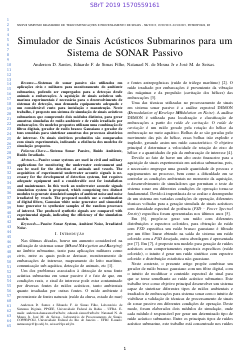
Simulador de Sinais Acústicos Submarinos para um Sistema de SONAR Passivo
Anderson Santos, Eduardo Simas Filho, José de Seixas, Natanael Nunes de Moura Junior
DOI: 10.14209/sbrt.2019.1570559161
Keywords:
Abstract
Sistemas de sonar passivo são utilizados em aplicações civis e militares para monitoramento do ambiente submarino, podendo ser empregados para a detecção de animais e embarcações. A aquisição de sinais acústicos submarinos experimentais demanda equipamento adequado e um considerável custo para instalação e manutenção. Neste trabalho é proposto um sistema de simulação de sinais acústicos submarinos que compreende dois módulos distintos para gerar amostras simuladas de ruído ambiente e de ruído irradiado por embarcações. Os modelos propostos utilizam uma combinação de filtros digitais, gerador de ruído branco Gaussiano e gerador de tons senoidais para sintetizar amostras dos processos aleatórios de interesse. Os sinais sintéticos produzidos são comparados com sinais experimentais, indicando a eficiência dos modelos de simulação. propostos.Download

Uma Avaliação de Desempenho de Modelos de Propagação para Redes Veiculares Urbanas
Gabriel Orofino, Natalia Fernandes, Diogo Mattos, Ricardo Carrano, Pedro Gonzalez Castellanos, Dianne Medeiros
DOI: 10.14209/sbrt.2019.1570559172
Keywords:
Abstract
The design of vehicular networks requires in-depth knowledge of signal behavior in the system, allowing to optimize the network performance for specific scenario. This paper aims to analyze the influence of propagation models on the performance of a vehicle-to-infrastrucutre communication. To this end, we use a network simulator configured based on real measurements that characterize the propagation environment. Performance is assessed by analyzing the delays, contact time, and packet delivery rate in the system. The results show that the scenario evaluated is best described by the Log-Distance model. In addition, there are differences on the values of delay, contact time and packets delivery rate obtained when the vehicle moves towards and away from the Road Side Unit (RSU). The best performance is reached when the vehicle moves towards the RSU.Download